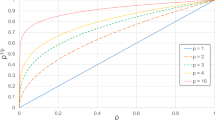Abstract
Preform design is an essential stage in forging especially for parts with complex shapes. In this paper, based on the evolutionary structural optimisation (ESO) concept, a topological optimisation method is developed for preform design. In this method, a new criterion for element elimination and addition on the workpiece boundary surfaces is proposed to optimise material distribution. To improve the quality of the boundary after element elimination, a boundary smoothing technique is developed using B-spline curve approximation. The developed methods are programmed using C# code and integrated with DEFORM 2D software package. Two 2D case problems including forging of an aerofoil shape and forging of rail wheel are evaluated using the developed method. The results suggest that the developed topology optimisation method is an efficient approach for preform design optimisation.


















Similar content being viewed by others
References
Altan T, Oh SI, Gegel HL (1983) Metal forming: fundamentals and applications (ASM Series in Metal Processing). ASM, Metals Park
Anna N, Frida B (2007) Topology optimization of a stamping die. AIP Conf Proc 908(1):449–454
Bendsoe MP, Sigmund O (1999) Material interpolation schemes in topology optimization. Arch Appl Mech 69:635–654
Deng Y, Chen H, Ma M, Zhang Y (2005) Studies of aircraft frame design based on topology optimization. Struct Environ Eng 32(2):39–45
Eschenauer HA, Olhoff N (2001) Topology optimization of continuum structures: a review. Appl Mech Rev 54(3):331–390
Gao T, Yang H, Liu Y-l (2006) Backward tracing simulation of precision forging process for blade based on 3D FEM. Trans Nonferr Met Soc China 16(Supplement 2):s639–s644
Hinton E, Sienz J (1995) Fully stressed topological design of structures using an evolutionary procedure. Eng Comput 12(3):229–244
Huang X, Xie ZM (2008) Topology optimization of nonlinear structures under displacement loading. Eng Struct 30(6):2057–2068
Huang X, Zuo ZH, Xie YM (2010) Evolutionary topological optimization of vibrating continuum structures for natural frequencies. Comput Struct 88:357–364
Kang BS, Kim N, Kobayashi S (1990) Computer-aided preform design in forging of an airfoil section blade. Int J Mach Tools Manuf 30:43–52
Kim N, Kobayashi S (1990) Preform design in H-shaped cross sectional axisymmetric forging by the finite element method. Int J Mach Tools Manuf 30(2):243–268
Kobayashi S, Oh SI, Altan T (1989) Metal forming and the finite-element method. Oxford University Press, New York
Lee SR, Lee YK, Park CH, Yang DY (2002) A new method of preform design in hot forging by using electric field theory. Int J Mech Sci 44:773–792
Naceur H, Guo YQ, Batoz JL (2004) Blank optimization in sheet metal forming using an evolutionary algorithm. J Mater Process Technol 151:183–191
Ou H, Balendra R (1998) Preform design for forging of aerofoil sections using FE simulation. J Mater Process Technol 80–81:144–148
Park JJ, Rebelo N, Kobayashi S (1983) A new approach to preform design in metal forming with the finite element method. Int J Mach Tool Des Res 23(1):71–79
Piegl L, Tiller W (1997) The NURBS book. Springer, New York
Querin O, Steven, G, Xie Y (1998) Evolutionary structural optimization (ESO) using a bidirectional algorithm. Eng Comput 15(7):1031–1048
Roy S, Ghosh S, Shivpuri R (1997) A new approach to optimal design of multi-stage metal forming processes with micro genetic algorithms. Int J Mach Tools Manuf 37(1):29–44
Rozvany GIN (2009) A critical review of established methods of structural topology optimization. Struct Multidisc Optim 37:217–237
Rozvany GIN, Zhou M, Birker T (1992) Generalized shape optimization without homogenization. Struct Multidisc Optim 4(3–4):250–252
SFTC (2007) DEFORM 2D version 8.1 user’s manual. www.deform.com. Ohio, Scientific Forming Technologies Corporation
Suzuki K, Kikuchi N (1991) A homogenization method for shape and topology optimization method. Comput Methods Appl Mech Eng 93:291–318
Xie YM, Steven GP (1993) A simple evolutionary procedure for structural optimization. Comput Struct 49(4):885–896
Xu Z, Lin Z, Wang H (2006) Lightweight design of auto-body structure by topology optimisation based on level set method. IET Conference Publications 2006(CP524):1818–1823
Yang YH, Liu D, He ZY, Luo ZJ (2009) Multi-objective preform optimization using RSM. Rare Metal Mater Eng 38(5):1019–1024
Zhao G, Wright ED, Grandhi RV (1997) Sensitivity analysis based preform die shape design for net-shape forging. Int J Mach Tools Manuf 37(8):1251–1271
Zhao G, Zhao Z, Wang T, Grandhi RV (1998) Preform design of a generic turbine disk forging process. J Mater Process Technol 84:193–201
Zhao X, Zhao G, Wang G, Wang T (2002) Preform die shape design for uniformity of deformation in forging based on preform sensitivity analysis. J Mater Process Technol 128(1–3):25–32
Zhou M, Rozvany GIN (2001) On the validity of ESO type methods in topology optimization. Struct Multidisc Optim 21:80–83
Acknowledgement
This research is supported by the National Nature Science Foundation of China 51005150.
Author information
Authors and Affiliations
Corresponding author
Rights and permissions
About this article
Cite this article
Lu, B., Ou, H. & Cui, Z.S. Shape optimisation of preform design for precision close-die forging. Struct Multidisc Optim 44, 785–796 (2011). https://doi.org/10.1007/s00158-011-0668-1
Received:
Revised:
Accepted:
Published:
Issue Date:
DOI: https://doi.org/10.1007/s00158-011-0668-1




